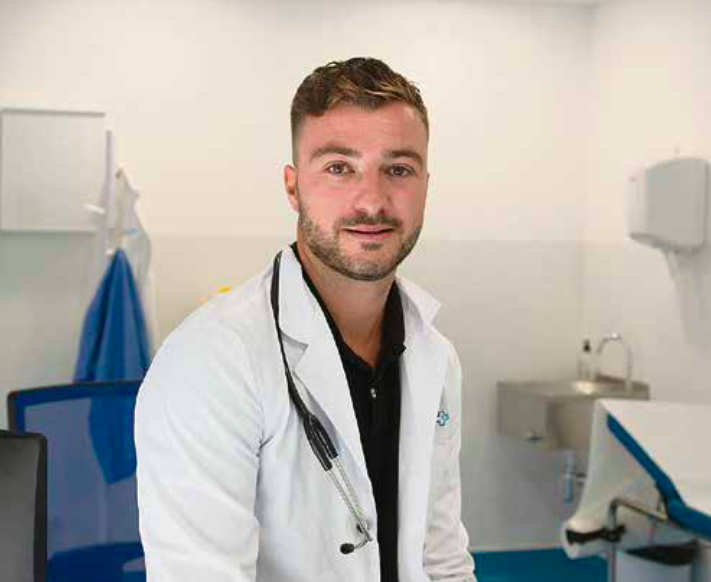

LOFLATIL

Ask a doctor about a prescription for LOFLATIL

How to use LOFLATIL
INSTRUCTIONS for medical use of the medicinal product DOXCEF (DOXCEF)
Composition
active substance: cefpodoxime; 1 film-coated tablet contains cefpodoxime proxetil in terms of cefpodoxime 100 mg or 200 mg; excipients: sodium lauryl sulfate, calcium carmellose, lactose monohydrate, hydroxypropylcellulose, magnesium stearate; Opadry 03A28718 white: hypromellose, titanium dioxide (E 171), talc.
Pharmaceutical form
Film-coated tablets.
Main physical and chemical properties
100 mg tablets: round, biconvex, white or almost white, film-coated tablets with an imprint of "100" on one side and smooth on the other; 200 mg tablets: round, biconvex, white or almost white, film-coated tablets with an imprint of "200" on one side and smooth on the other.
Pharmacotherapeutic group
Antimicrobial agents for systemic use. Other beta-lactam antibiotics. Third-generation cephalosporins. ATC code J01D D13.
Pharmacological properties
Pharmacodynamics
Doxcef (cefodoxime proxetil) is a third-generation beta-lactam antibiotic for oral administration. Its bactericidal effect is due to the inhibition of bacterial cell wall synthesis. In vitro, the drug has shown bactericidal activity against many Gram-positive and Gram-negative microorganisms.
Sensitive Gram-positive bacteria: Streptococcus pneumoniae, streptococci group A (S. pyogenes), B (S. agalactiae), C, F, G, as well as S. mitis, S. sanguis, S. salivarius, and Corynebacterium diphtheriae.
Sensitive Gram-negative bacteria: Haemophilus influenzae, Haemophilus parainfluenzae, Moraxella (Branhamella) catarrhalis (strains that produce and do not produce beta-lactamase), Neisseria meningitidis, Neisseria gonorrhoeae, Escherichia coli, Klebsiella spp. (K. pneumoniae; K. oxytoca), Proteus mirabilis.
Doxcef is moderately active against methicillin-sensitive staphylococci and strains that produce and do not produce penicillinase (S. aureus and S. epidermidis).
The following microorganisms are resistant to cefpodoxime, as well as to other cephalosporins: enterococci, methicillin-resistant staphylococci (S. aureus and S. epidermidis), Staphylococcus saprophyticus, Pseudomonas aeruginosa, and Pseudomonas spp., Clostridium difficile, Bacteroides fragilis.
Pharmacokinetics
The active substance of Doxcef is absorbed in the small intestine and hydrolyzed to the active metabolite cefpodoxime. The maximum plasma concentration is reached 2-3 hours after a single dose and is 1.2 mg/l and 2.5 mg/l for doses of 100 mg and 200 mg, respectively.
It binds to plasma proteins (mainly albumins - 40%), binding is of a non-saturated type. The minimum inhibitory concentration (MIC) of cefpodoxime for most pathogens can be achieved in the parenchyma of the lungs, the mucous membrane of the bronchi, pleural fluid, tonsils, interstitial fluid, and tissues of the prostate gland.
The concentration of cefpodoxime is high. Within 12 hours after a single dose, the MIC90 concentration of common urinary tract infection pathogens is achieved. It is excreted mainly with urine, the half-life is about 2.4 hours.
Clinical characteristics
Indications
Infections caused by microorganisms sensitive to cefpodoxime:
- Infections of the LOR organs (including sinusitis, tonsillitis, pharyngitis); for the treatment of tonsillitis and pharyngitis, Doxcef is prescribed in case of chronic or recurrent infection, as well as in cases of known or suspected insensitivity of the pathogen to widely used antibiotics;
- respiratory tract infections (including acute bronchitis, recurrences or exacerbations of chronic bronchitis, bacterial pneumonia);
- uncomplicated infections of the upper and lower urinary tract (including acute cystitis and pyelonephritis);
- skin and soft tissue infections (abscesses, cellulitis, infected wounds, furuncles, folliculitis, paronychia, carbuncles, and ulcers);
- uncomplicated gonococcal urethritis.
Contraindications
Increased sensitivity to cephalosporin or penicillin drugs.
Hereditary galactose intolerance, lactase deficiency, or glucose/galactose malabsorption syndrome.
Interaction with other medicinal products and other types of interactions
Drugs that block histamine H2 receptors and antacids reduce the bioavailability of the drug. Simultaneous use of the drug with loop diuretics may increase nephrotoxicity. It is recommended to carefully monitor renal function if Doxcef tablets are prescribed simultaneously with drugs that have a nephrotoxic effect. Probenecid delays the excretion of cefpodoxime.
Special warnings and precautions for use
About 5-10% of patients with an allergy to penicillin have a cross-reaction to cephalosporins, so before prescribing cephalosporins, it is necessary to clarify the possible presence of an allergy to penicillin in the patient and ensure strict medical supervision from the first day of using Doxcef.
Patients who are allergic to other cephalosporins should be aware of the possibility of cross-allergy to cefpodoxime. Doxcef should not be prescribed to patients with a history of hypersensitivity reactions to cephalosporins. Hypersensitivity reactions (anaphylaxis) that occur with beta-lactam antibiotics can be severe, sometimes fatal. If the first signs of hypersensitivity appear, the use of the drug should be stopped.
Doxcef should not be used to treat atypical pneumonia caused by bacteria such as Legionella, Mycoplasma, Chlamydia.
For patients with renal insufficiency, the dosing regimen should be adjusted depending on the creatinine clearance rate (recommended doses are given in Table 2). The use of Doxcef in combination with potentially nephrotoxic drugs (aminoglycosides, furosemide) may worsen renal function. During treatment, it is recommended to monitor renal function indicators.
Possible side reactions, including those from the gastrointestinal tract (e.g., vomiting, nausea, abdominal pain). Antibiotics should always be prescribed with caution to patients with gastrointestinal diseases, especially those with colitis.
Treatment with Doxcef and other broad-spectrum antibiotics can lead to an imbalance of intestinal microflora, which can cause diarrhea, colitis, including pseudomembranous colitis caused by Clostridium difficile toxin. These side reactions, which can occur most often in patients who have received high doses of cefpodoxime for a long time, should be considered potentially severe.
A study for the presence of Clostridium difficile is necessary. If colitis is suspected, the use of Doxcef should be stopped immediately. It is necessary to confirm the diagnosis by sigmoidoscopy and rectoscopy, and if clinically necessary, prescribe another antibiotic (vancomycin).
Drugs that cause retention of fecal masses should be avoided.
As with other beta-lactam antibiotics, long-term use of Doxcef can lead to the development of neutropenia, very rarely - agranulocytosis. Blood tests should be monitored, and therapy should be stopped in case of neutropenia.
In some individuals, during treatment, a positive direct Coombs test is possible. A decrease in hemoglobin levels, very rarely - cases of hemolytic anemia, can be observed.
Long-term use of cefpodoxime can lead to an overgrowth of non-susceptible microorganisms.
Severe skin reactions (SSR)
Severe skin reactions (SSR), including Stevens-Johnson syndrome (SJS), toxic epidermal necrolysis (TEN), drug-induced eosinophilia with systemic symptoms (DRESS), and acute generalized exanthematous pustulosis (AGEP), which can be life-threatening or fatal, have been reported with an unknown frequency in connection with the use of cefpodoxime.
Patients should be informed about the signs and symptoms and carefully monitored for skin reactions.
If signs and symptoms of these reactions appear, cefpodoxime should be discontinued immediately and the possibility of alternative treatment should be considered.
If a patient develops a severe reaction, such as SJS, TEN, DRESS, or AGEP, while taking cefpodoxime, treatment with cefpodoxime should not be resumed under any circumstances.
Use during pregnancy or breastfeeding
Well-controlled studies on the use of cefpodoxime in pregnant women have not been conducted, so Doxcef can be used in this category of patients only if there is a justified need.
Cefpodoxime penetrates into breast milk, so if its use is necessary, breastfeeding should be stopped.
Ability to influence the reaction rate when driving vehicles or working with other mechanisms
When using cefpodoxime, dizziness may occur, which can affect the ability to drive a car or work with complex mechanisms.
Method of application and doses
Tablets are taken orally during meals to enhance absorption.
The duration of treatment depends on the severity of the disease and is determined individually.
Recommended doses for adults and children over 12 years old with normal renal function:
| Infections | Total daily dose | Dosing regimen |
|---|---|---|
| Infections of the LOR organs: sinusitis, other infections (including tonsillitis, pharyngitis) | 400 mg, 200 mg | 200 mg twice a day, 100 mg twice a day |
| Respiratory tract infections (including acute bronchitis, recurrences or exacerbations of chronic bronchitis, bacterial pneumonia) | 200-400 mg (depending on the sensitivity of the pathogen) | 100-200 mg twice a day |
| Uncomplicated infections of the upper and lower urinary tract: upper (acute pyelonephritis), lower (cystitis) | 400 mg, 200 mg | 200 mg twice a day, 100 mg twice a day |
| Skin and soft tissue infections (abscesses, cellulitis, infected wounds, furuncles, folliculitis, paronychia, carbuncles, and ulcers) | 400 mg | 200 mg twice a day |
| Uncomplicated gonococcal urethritis | 200 mg | once |
Elderly patients.
There is no need to change the dose for elderly patients with normal renal function.
Liver function disorders.
There is no need to change the dose for patients with liver insufficiency.
Renal function disorders.
There is no need to change the dose for patients with impaired renal function if creatinine clearance is more than 40 ml/min.
| Creatinine clearance (ml/min) | Recommended dose |
|---|---|
| 39-10 | 100 mg or 200 mg (depending on the type of infection) every 24 hours |
| < 10 | 100 mg or 200 mg (depending on the type of infection) every 48 hours |
| Patients on hemodialysis | 100 mg or 200 mg (depending on the type of infection) after each dialysis session |
Children.
Doxcef tablets are prescribed for children over 12 years old.
For children under 12 years old, it is recommended to use Doxcef powder for oral suspension.
Overdose
Symptoms: nausea, vomiting, abdominal pain, diarrhea. In case of overdose, especially in patients with renal insufficiency, encephalopathy may occur.
Cases of encephalopathy are usually reversible at low levels of cefpodoxime in the blood plasma.
Treatment: hemodialysis, peritoneal dialysis. Symptomatic therapy.
Side reactions
The following classification of the frequency of side effects is used: very often (> 1/10), often (> 1/100, < 1/10), uncommon (> 1/1000, < 1/100), rare (> 1/10 000, < 1/1000), very rare (<1/10 000).
Infections and invasions: rare - superinfection caused by some fungi of the genus Candida, insensitive to cefpodoxime; very rare - colitis associated with antibiotic use.
From the blood system: rare - eosinophilia; very rare - leukopenia, neutropenia, thrombocytopenia, thrombocytosis, agranulocytosis, decreased hemoglobin concentration, hemolytic anemia.
From the immune system: rare - hypersensitivity, anaphylactic reactions.
Metabolic disorders: rare - dehydration, gout, peripheral edema, weight gain.
From the musculoskeletal system: rare - myalgia.
From the nervous system: uncommon - headache; rare - vertigo; very rare - dizziness, insomnia, drowsiness, nervousness, irritability, unusual dreams, impaired vision, confusion, night terrors, paresthesia.
From the respiratory system: rare - asthma, cough, nosebleeds, rhinitis, wheezing, bronchitis, dyspnea, pleural effusion, pneumonia, sinusitis.
From the gastrointestinal tract: rare - diarrhea; uncommon - abdominal pain, nausea; rare - feeling of thirst, tenesmus, bloating, vomiting, dyspepsia, dry mouth, decreased appetite, constipation, candidal stomatitis, anorexia, belching, gastritis, oral ulcers, pseudomembranous colitis.
From the hepatobiliary system: rare - cholestatic liver damage.
From the skin and subcutaneous tissue: rare - rash, itching, urticaria, increased sweating, maculopapular rash, fungal dermatitis, desquamation, dry skin, hair loss, vesicular rash, sunburn, purpura, bullous reactions (including Stevens-Johnson syndrome), toxic epidermal necrolysis, multiform erythema; unknown - acute generalized exanthematous pustulosis (AGEP), drug-induced eosinophilia with systemic symptoms (DRESS).
From the genitourinary system: rare - hematuria, urinary tract infections, metrorrhagia, dysuria, frequent urination, proteinuria, vaginal candidiasis.
From the cardiovascular system: rare - congestive heart failure, migraine, tachycardia, vasodilation, hematoma, arterial hypertension or hypotension.
From the organs of perception: rare - taste disturbances, eye irritation, tinnitus.
General disorders: rare - discomfort, fatigue, asthenia, drug fever, chest pain (pain may radiate to the back), fever, generalized pain, candidiasis, abscess, allergic reaction, facial edema, bacterial infections, parasitic infections.
Laboratory indicators: rare - increased liver function test indicators AST, ALT, alkaline phosphatase, bilirubin, urea, and creatinine, pseudopositive Coombs test.
Shelf life
100 mg tablets - 3 years.
200 mg tablets - 2 years.
Storage conditions
Store at a temperature not exceeding 25 °C. Store in a place inaccessible to children.
Packaging
10 tablets in a blister pack, 1 blister pack in a cardboard box.
Release category
By prescription.
Manufacturer
Lupin Limited.
Location of the manufacturer and the address of the place of its activity
198-202, New Industrial Area No. 2, Mandideep (Unit-1) - 462046, Dist Raisen, M.P., India.
Applicant
Sky Pharma LLC.
Location of the applicant
Premises No. 708S, Floor 7, Dubai Science Park (DSP), South Tower, Dubai Science Park, Dubai, United Arab Emirates.
- Country of registration
- Active substance
- Prescription requiredYes
- Manufacturer
- This information is for reference only and does not constitute medical advice. Always consult a licensed doctor before taking any medication. Oladoctor is not responsible for medical decisions based on this content.
- Alternatives to LOFLATILDosage form: capsules, 10 capsules in a blisterActive substance: loperamide, combinationsManufacturer: Мепро Фармасьютикалс Пріват ЛімітедPrescription not requiredDosage form: drops, 10 mg/mlActive substance: opiumManufacturer: Ломафарм ГмбХPrescription requiredDosage form: capsules, 2 mgActive substance: loperamideManufacturer: Салютас Фарма ГмбХPrescription not required
Alternatives to LOFLATIL in other countries
The best alternatives with the same active ingredient and therapeutic effect.
Alternative to LOFLATIL in Espanha
Online doctors for LOFLATIL
Discuss dosage, side effects, interactions, contraindications, and prescription renewal for LOFLATIL – subject to medical assessment and local rules.














